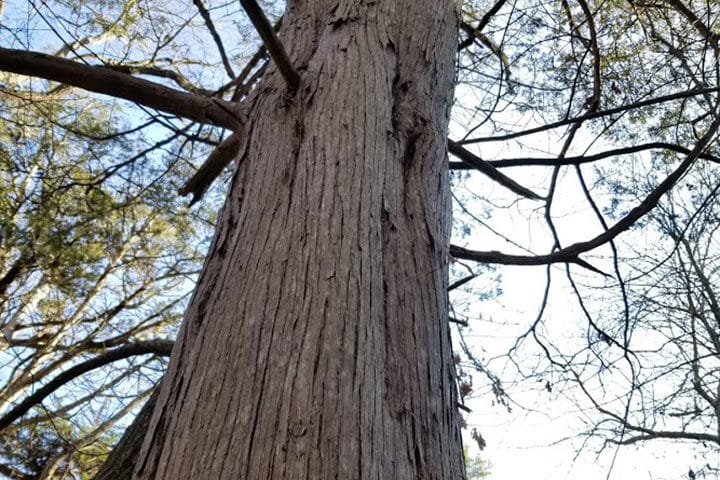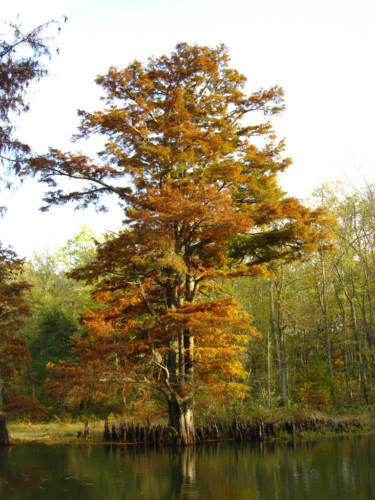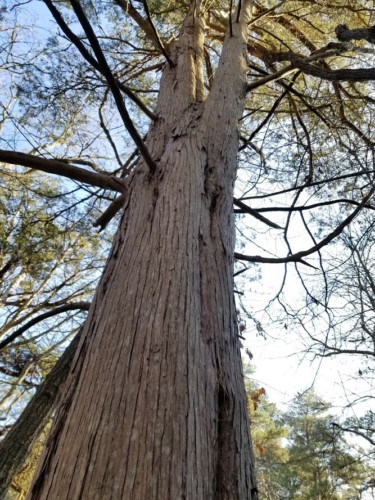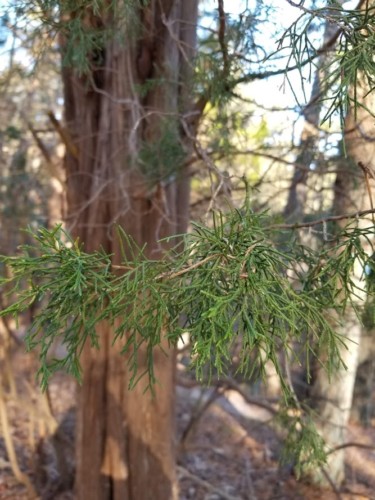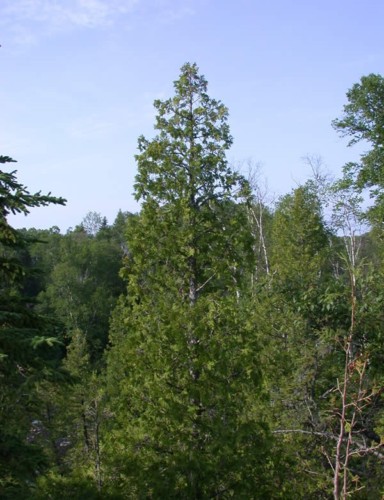Conifers are important members of our forests year-round, but visually are most prominent during the winter when their evergreen leaves stand out in a sea of dormant deciduous limbs. To the untrained eye these trees may all look the same, but there is a vast amount of diversity among this ancient group of plants.
Conifers are gymnosperms, meaning plants that produce seed but do not flower or fruit. When gymnosperms evolved in the Carboniferous period, all of the other plants on earth required moist conditions to reproduce. Gymnosperm pollen and seeds have a hard coating, which allow them to tolerate dry conditions and enabled their colonization of the vast inland areas previously inhospitable to earlier plant life. By the Mesozoic Era (the “Age of the Reptiles”), conifers dominated the land, and were thus the primary food source for herbivorous dinosaurs until the evolution and dominance of flowering plants in the Cretaceous period. The next time you struggle to get pine sap off of your hands, think about how the resins likely developed as a defense mechanism against dinosaur herbivory!
Today, all surviving conifers arise from the taxonomic order Pinales, of the class Pinopsida, and division Pinophyta. In the Chesapeake Bay Watershed, all conifers fall into two families: Cupressaceae, the cypress family, and Pinaceae, the pine family.
Have you ever wanted to know how to tell a pine from a hemlock from a spruce from a juniper? In this two-part blog series, I will highlight distinguishing traits of each conifer genus found in the Chesapeake Bay Watershed, starting with the Cupressaceae family. Ultimately, I hope learning these traits will leave you better informed when exploring your woods this winter.
A bald cypress changing color in the fall. Note the “knees” surrounding the tree. Photo credit: Chris M, Flickr.
Cypress – Taxodium species
Bald cypress (Taxodium distichum var. distichum), and the closely related pond cypress (Taxodium distichum var. imbricarium), are unique, iconic trees found on the coastal plain of Virginia, Maryland, Delaware, and the rest of the southeast. They have reddish, fibrous bark, buttressed trunk bases, and are often found in very wet soil or standing water, where they will develop “knees”, which are root protrusions above the soil and water. Their cones are spherical and a bit bigger around than a quarter. Bald and pond cypress are deciduous conifers, losing all of their needles each autumn. Both species have soft needles on deciduous lateral twigs; the bald cypress leaves are held laterally, in a feather-like formation, while the pond cypress leaves are more scale-like and held close to the lateral twig.
Atlantic white cedar trunk, located near the tidal Maurice River in southern New Jersey. Photo credit: Ryan Davis.
Chamaecyparis thyoides– Atlantic White Cedar
The only member of its genus in the eastern US, the Atlantic white cedar is found along the coast from Maine to Mississippi, almost always below 350 feet in elevation. If you’re more than a few miles from the Atlantic ocean, you’re not likely to see Atlantic white cedar. It has scale-like blue-green leaves, typically held in flattened bunches, and small, grayish-blue cones. The branches usually taper so that the crown is very conical. Its bark is fibrous, reddish gray in color, and the long vertical bark strips sometimes spiral up the trunk.
One wouldn’t expect a specialist of wet coastal forests to be fire-tolerant, but this species fares well in periodically burned forests. They germinate best in bare soil, and typically self-prune lower limbs so that fires rarely reach the crown. The lightweight, rot-resistant wood of Atlantic white cedar was once incredibly important commercially and was widely used in shipbuilding, but few stands now remain due largely to development and fire suppression.
Leaves of a mature eastern redcedar, with the reddish fibrous bark in the background. Photo credit: Ryan Davis.
Juniperus virginiana– Eastern Redcedar
This tree, which can look similar to the Atlantic white cedar, is also the only one of its genus in the eastern US. Unlike the Atlantic white cedar, however, it is very common and widespread; eastern redcedar (also known as juniper) is in fact the most widely distributed conifer in the United States. Redcedar is also the most commercially valuable juniper; its wood is durable, easy to work, and smells wonderful. The aroma does not repel moths as is commonly claimed, but compounds released by the wood do kill moth larvae. The tree is not universally beloved; its prolific growth and propensity to spring up in fields and along fences irritate many landowners, and it is probably called a “weed” by as many people that enthusiastically plant it.
Mature juniper branches have scalelike dark green leaves, while young shoots have flattened, sharp leaves that are whorled. The tree changes shape as it ages; older trees are very conical while younger trees tend to be more cylindrically shaped. While these trees are often thought of as fast-growing pioneers because they spring up in abandoned fields, they actually grow slowly and do not reach maturity until they are around 300 years old. The cones are small, berrylike waxy spheres that are a dusky blue in color and greedily eaten by songbirds.
A mature white cedar tree in Minnesota. Photo credit: Peter M. Dziuk.
Thuja occidentalis– Arborvitae
Also known as northern whitecedar, arborvitae is the only Thuja species found in the eastern US. Its native range is mostly in New England, the northern midwest, and eastern Canada, but in the Chesapeake Bay Watershed it is found in small pockets of high-elevation forest. Cultivated varieties have become very popular; you are quite likely to see arborvitae used in landscaping as hedges or living privacy fences thanks to its dense foliage. According to North American Trees by Preston and Braham, it was valued by colonists for the high vitamin C content in its leaves. Indeed, its ability to prevent scurvy is where its name (roughly “tree of life”) is derived. For this and other medicinal purposes, arborvitae may have been the first North American tree species to be introduced to Europe.
Arborvitae is a small, dense, conical tree with thin, grayish red, fibrous bark. It has scalelike leaves that are held in flattened shoots. Its cones are golden-brown and oblong, and its strobili (the conifer version of flowers) are tiny brown structures borne on separate branchlet tips. Be sure to check out next month’s article to learn how to identify the members of the Pinaceae family: pines, hemlock, spruces, and firs! For more information, contact Ryan Davis at rdavis@allianceforthebay.org, or visit forestsforthebay.org.
